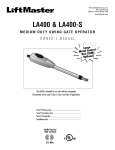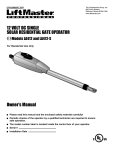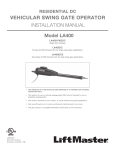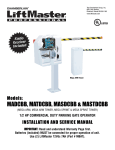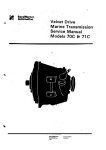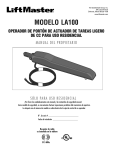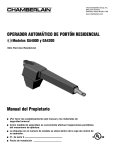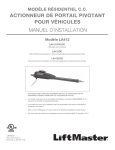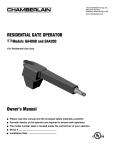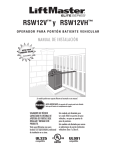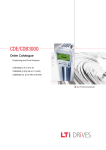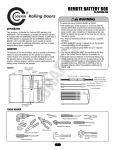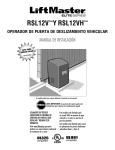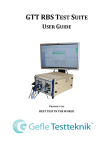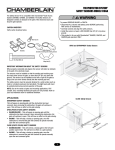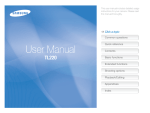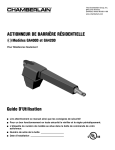Download LA412 & LA412-S - LiftMaster
Transcript
The Chamberlain Group, Inc. 845 Larch Avenue Elmhurst, Illinois 60126-1196 www.liftmaster.com LA412 & LA412-S 12 VOLT DC SOLAR RESIDENTIAL SWING GATE OPERATOR OWN E R ' S MAN UAL Large trol Metal ConM) Box (XL Op tional FOR RESIDENTIAL USE ONLY Please read this manual and the enclosed safety materials carefully! Periodic checks of the operator by a qualified technician are required to ensure safe operation. The model number is located inside the control box of your operator. Serial # Installation date TABLE OF CONTENTS SAFETY Safety Symbol and Signal Word Review Safety Installation Information Gate Construction Information Important Safety Information INTRODUCTION 1-5 SOLAR PANEL INSTALLATION 1 2 3 4-5 Overview of Typical Installation Check Your Gate Mounting Options Manual Release Determine the Position of the Pull-to-Open Bracket Determine the Position of the "Optional" Push-to-Open Bracket Assemble Gate Post Bracket (Pull-to-Open) Attach Brackets to Gate Operator Determine Mounting Location Measuring and Marking for the Gate Bracket Position Gate Operator on Gate Test Gate Travel Secure Post Bracket to Gate Post Secure Gate Bracket to Gate Warning Sign Placement Standard Control Box Large Metal Control Box (XLM) WIRING 29-32 Limits Force Adjustment Timer-to-Close 6-7 Operator Specifications Carton Inventory Hardware Inventory Additional Items for Purchase Tools Needed INSTALLATION ADJUSTMENT 6 6 7 7 7 29-31 32 32 PROGRAMMING 33 Remote Controls Keyless Entry Erase All Codes Test 8-19 33 33 33 33 OPERATION AND MAINTENANCE 8-9 10 10 11 11 11 12 12 13 13 14 15 15 16 16 17-18 19 Reset Button Remote Control Sleep Mode Manual Release Maintenance 36-39 Wiring Diagram Diagnostic Chart Troubleshooting Chart 36 37 38-39 REPAIR PARTS 40-41 Control Box Gate Operator Arm How to Order Repair Parts Connect the Gate Operator (Gate 1) to the Control Box 20 Set the Lock/Bipart Delay (Model LA412-S Only) 21 Connect the Gate Operator (Gate 2) to the Control Box (Model LA412-S Only) 22 Junction Box (Model LA412-S Only) 23-24 40 40 41 WARRANTY POLICY 41 ACCESSORIES 42 TEMPLATE SAFETY » SAFETY SYMBOL AND SIGNAL WORD REVIEW When you see these Safety Symbols and Signal Words on the following pages, they will alert you to the possibility of Serious Injury or Death if you do not comply with the warnings that accompany them. The hazard may come from something mechanical or from electric shock. Read the warnings carefully. When you see this Signal Word on the following pages, it will alert you to the possibility of damage to your gate and/or the gate operator if you do not comply with the cautionary statements that accompany it. Read them carefully. BACK COVER MECHANICAL IMPORTANT NOTE • BEFORE attempting to install, operate or maintain the operator, you must read and fully understand this manual and follow all safety instructions. • DO NOT attempt repair or service of your gate operator unless you are an Authorized Service Technician. ELECTRICAL 1 34-35 34 34 34 35 35 TROUBLESHOOTING 20-24 25-28 SAFETY » SAFETY INSTALLATION INFORMATION 10. 1. READ and FOLLOW all instructions. 2. The gate operator is intended for use with Class I vehicular swing gates. Class I denotes a vehicular gate operator (or system) intended for use in a home of one to four single family dwellings, or a garage or parking area associated therewith. Install the gate operator only when the operator is appropriate for the construction and the usage class of the gate. 3. Gate operating system designers, installers and users must take into account the possible hazards associated with each individual application. Improperly designed, installed or maintained systems can create risks for the user as well as the bystander. Gate system design and installation must reduce public exposure to potential hazards. Install the gate operator only when the operator is appropriate for the construction of the gate and the usage class of the gate. All exposed pinch points must be eliminated or guarded. 4. A gate operator can create high levels of force during normal operation. Therefore, safety features must be incorporated into every installation. Specific safety features include photoelectric sensors. 5. The gate must be properly installed and work freely in both directions prior to the installation of the gate operator. 6. The gate must be installed in a location so that enough clearance is provided between the gate and adjacent structures when opening and closing to reduce the risk of entrapment. Swinging gates shall not open into public access areas. 7. The operator is intended for use only on gates used for vehicles. Pedestrians must be supplied with a separate access opening. The pedestrian access opening shall be designed to promote pedestrian usage. The pedestrian access shall be located such that persons will not come in contact with the moving vehicular gate. 8. Pedestrians should never cross the pathway of a moving gate. The gate operator is not acceptable for use on any pedestrian gate. Pedestrians must be supplied with a separate pedestrian access. 11. 12. For a gate operator utilizing a contact sensor such as an edge sensor: a. A hard wired contact sensor shall be located and its wiring arranged so the communication between the sensor and the gate operator is not subject to mechanical damage. b. One or more contact sensors shall be located on the inside and outside leading edge of a swing gate. Additionally, if the bottom edge of a swing gate is greater than 6 inches (152 mm) above the ground at any point in its arc of travel, one or more contact sensors shall be located on the bottom edge. Never mount any device that operates the gate operator where the user can reach over, under, around or through the gate to operate the controls. Controls are to be placed at least 6 feet (1.8 m) from any part of the moving gate: • A hard wired control device shall be located and its wiring arranged so that communication between the control device and the gate operator is not subject to mechanical damage. Controls intended to be used to reset an operator after 2 sequential activations of the entrapment protection device or devices must be located in the line of sight of the gate, or easily accessible controls shall have a security feature to prevent unauthorized use. Never allow anyone to hang on or ride the gate during the entire travel of the gate. 13. Each gate operator is provided with two safety warning placards. The placards are to be installed on the front and back of the gate where they are plainly visible. The placards may be mounted using cable ties through the four holes provided on each placard. All warning signs and placards must be installed where visible in the area of the gate. 9. For an installation utilizing non-contact sensors (photoelectric sensors), see product manual on the placement of non-contact sensors (photoelectric sensors) for each type of application. a. Care shall be exercised to reduce the risk of nuisance tripping, such as when a vehicle trips the photoelectric sensor while the gate is still moving. b. One or more non-contact sensors (photoelectric sensors) shall be located where the risk of entrapment or obstruction exists, such as the perimeter reachable by a moving gate or barrier. 14. 15. 2 To AVOID damaging gas, power, or other underground utility lines, contact underground utility locating companies BEFORE digging. SAVE THE INSTRUCTIONS. SAFETY » GATE CONSTRUCTION INFORMATION Vehicular gates should be installed in accordance with ASTM F2200: Standard Specification for Automated Vehicular Gate Construction. For a copy, contact ASTM directly at 610-832-9585 or www.astm.org. 1. GENERAL REQUIREMENTS 1.1 Gates shall be constructed in accordance with the provisions given for the appropriate gate type listed, refer to ASTM F2200 for additional gate types. 1.2 Gates shall be designed, constructed and installed to not fall over more than 45 degrees from the vertical plane, when a gate is detached from the supporting hardware. 1.3 Gates shall have smooth bottom edges, with vertical bottom edged protrusions not exceeding 0.50 inches (12.7 mm) when other than the exceptions listed in ASTM F2200. 1.4 3.1.3 A gap, measured in the horizontal plane parallel to the roadway, between a fixed stationary object nearest the roadway, (such as a gate support post) and the gate frame when the gate is in either the fully open position or the fully closed position, shall not exceed 2-1/4 inches (57 mm), refer to ASTM F2200 for Exception. 3.1.4 The minimum height for barbed tape shall not be less than 8 feet (2.44 m) above grade and for barbed wire shall not be less than 6 feet (1.83 m) above grade. Positive stops shall be required to limit travel to the designed fully open and fully closed positions. These stops shall be installed at either the top of the gate, or at the bottom of the gate where such stops shall horizontally or vertically project no more than is required to perform their intended function. 3.1.5 All gates shall be designed with sufficient lateral stability to assure that the gate will enter a receiver guide, refer to ASTM F2200 for panel types. 1.5 An existing gate latch shall be disabled when a manually operated gate is retrofitted with a powered gate operator. 3.2 The following provisions shall apply to Class IV vehicular horizontal slide gates: 1.6 A gate latch shall not be installed on an automatically operated gate. 3.2.1 1.7 Protrusions shall not be permitted on any gate, refer to ASTM F2200 for Exceptions. All weight bearing exposed rollers 8 feet (2.44 m), or less, above grade shall be guarded or covered. 3.2.2 Positive stops shall be required to limit travel to the designed fully open and fully closed positions. These stops shall be installed at either the top of the gate, or at the bottom of the gate where such stops shall horizontally or vertically project no more than is required to perform their intended function. 4. VEHICULAR HORIZONTAL SWING GATES 4.1 The following provisions shall apply to Class 1, Class II and Class III vehicular horizontal swing gates: 4.1.1 Gates shall be designed, constructed and installed so as not to create an entrapment area between the gate and the supporting structure or other fixed object when the gate moves toward the fully open position, subject to the provisions in the 4.1.1.1 and 4.1.1.2. 1.8 Gates shall be designed, constructed and installed such that their movement shall not be initiated by gravity when an automatic operator is disconnected. 1.9 A pedestrian gate shall not be incorporated into a vehicular gate panel or that portion of the adjacent fence that the gate covers in the open position. 2. SPECIFIC APPLICATIONS 2.1 Any non-automated gate that is to be automated shall be upgraded to conform to the provisions of this specification. 2.2 This specification shall not apply to gates generally used for pedestrian access and to vehicular gates not to be automated. 2.3 Any existing automated gate, when the operator requires replacement, shall be upgraded to conform to the provisions of this specification in effect at that time. 3. VEHICULAR HORIZONTAL SLIDE GATES 3.1 The following provisions shall apply to Class I, Class II and Class III vehicular horizontal slide gates: 3.1.1 All weight bearing exposed rollers 8 feet (2.44 m), or less, above grade shall be guarded or covered. 3.1.2 All openings located between 48 inches (1.22 m) and 72 inches (1.83 m) above grade shall be designed, guarded or screened to prevent a 4 inch (102 mm) diameter sphere from passing through the openings anywhere in the gate, and in that portion of the adjacent fence that covers in the open position. 4.1.1.1 The width of an object (such as a wall, pillar or column) covered by a swing gate when in the open position shall not exceed 4 inches (102 mm), measured from the centerline of the pivot point of the gate, refer to ASTM F2200 for exception. 4.1.1.2 Except for the zone specified in Section 4.1.1.1, the distance between a fixed object such as a wall, pillar or column, and a swing gate when in the open position shall not be less than 16 inches (406 mm), refer to ASTM F2200 for exception. 4.2 3 Class IV vehicular horizontal swing gates shall be designed, constructed and installed in accordance with security related parameters specific to the application in question. SAFETY » IMPORTANT SAFETY INFORMATION INSTALLATION To prevent SERIOUS INJURY or DEATH; one or more non-contact sensors shall be located where the risk of entrapment or obstruction exists. To prevent SERIOUS INJURY or DEATH from a moving gate: • Install warning signs on the front and back of the gate in PLAIN VIEW. • Permanently secure each warning sign in a suitable manner using fastening holes. ALWAYS wear protective gloves and eye protection when changing the battery or working around the battery compartment. • DO NOT use flooded lead acid battery. • Flooded lead acid batteries will produce gases when discharging and recharging which can explode. • DO NOT dispose of battery in fire. Battery may explode. Check with local codes for disposal instructions. WIRING To reduce the risk of SEVERE INJURY or DEATH: • BEFORE installing power wiring or control stations be sure to follow ALL specifications and warnings described below. • ANY maintenance to the operator or in the area near the operator MUST NOT be performed until the batteries are disconnected. Upon completion of maintenance the area MUST be cleared and secured, at that time the unit may be returned to service. • ALL electrical connections MUST be made by a qualified individual. • DO NOT install ANY wiring or attempt to run the operator without consulting the wiring diagram. We recommend that you install an optional reversing edge BEFORE proceeding with the control station installation. To AVOID damaging gas, power or other underground utility lines, contact underground utility locating companies BEFORE digging. SOLAR PANEL INSTALLATION To avoid SERIOUS INJURY or DEATH: • Disconnect ALL electric and battery power BEFORE performing ANY service or maintenance. • DO NOT connect solar panel(s) when power supply is connected. • DO NOT connect more than 30W (3 solar panels). To reduce the risk of FIRE or INJURY to persons use ONLY LiftMaster part 29-NP712 for replacement batteries. ADJUSTMENT Without a properly installed safety reversal system, persons (particularly small children) could be SERIOUSLY INJURED or KILLED by a closing gate. • Too much force on gate will interfere with proper operation of safety reversal system. • NEVER increase force beyond minimum amount required to close gate. • NEVER use force adjustments to compensate for a binding or sticking gate. • If one control (force or travel limits) is adjusted, the other control may also need adjustment. • After ANY adjustments are made, the safety reversal system MUST be tested. Gate MUST reverse on contact with a rigid object. 4 SAFETY » IMPORTANT SAFETY INFORMATION PROGRAMMING To prevent possible SERIOUS INJURY or DEATH from a moving gate or garage door: • ALWAYS keep remote controls out of reach of children. NEVER permit children to operate, or play with remote control transmitters. • Activate gate or door ONLY when it can be seen clearly, is properly adjusted, and there are no obstructions to door travel. • ALWAYS keep gate or garage door in sight until completely closed. NEVER permit anyone to cross path of moving gate or door. OPERATION AND MAINTENANCE To reduce the risk of SEVERE INJURY or DEATH: • READ AND FOLLOW ALL INSTRUCTIONS. • NEVER let children operate or play with gate controls. Keep the remote control away from children. • ALWAYS keep people and objects away from the gate. NO ONE SHOULD CROSS THE PATH OF THE MOVING GATE. • Test the gate operator monthly. The gate MUST reverse on contact with a rigid object or stop when an object activates the non-contact sensors. After adjusting the force or the limit of travel, retest the gate operator. Failure to adjust and retest the gate operator properly can increase the risk of INJURY or DEATH. • Use the emergency release ONLY when the gate is not moving. • KEEP GATES PROPERLY MAINTAINED. Read the ownerʼs manual. Have a qualified service person make repairs to gate hardware. • The entrance is for vehicles ONLY. Pedestrians MUST use separate entrance. • Disconnect ALL power BEFORE performing ANY maintenance. • SAVE THESE INSTRUCTIONS. TROUBLESHOOTING To protect against fire and electrocution: • DISCONNECT power and battery BEFORE installing or servicing operator. For continued protection against fire: • Replace ONLY with fuse of same type and rating. 5 INTRODUCTION » OPERATOR SPECIFICATIONS + CARTON INVENTORY OPERATOR SPECIFICATIONS Main Supply (Motor): Accessory Power: 12 Vdc Battery run 12 V nominal Class II battery voltage source is limited to: • Solar or AC Cable up to 50 feet - 500 mA 14" (35.6 cm) • AC Cable 50 feet up to 250 feet - 250 mA RESET • AC Cable 250 feet up to 1000 feet - 100 mA NOTE: Increased accessory power drawn from the operator will shorten the battery life. Battery Charger Supply (Optional): Maximum Gate Length Weight/Length: Temperature: Fuse Protection Battery: Protection Fuse Battery 2: Solar Power Max: lbs./16 lbs./14 lbs./12 lbs./10 ft ft ft ft 6" (15.2 cm) 36.3" (92.1 cm) 4" (10.2 cm) 14.5 Vac, 30 VA max. 550 650 750 850 10" (25.4 cm) Weight: 13.2 lbs. (6 kg.) .475" DIA. (1.2 cm DIA.) long long long long 37.4" (95 cm) 4.5" (11.2 cm) -20° C to 50° C (-4° F to 122° F) .25" (0.635 cm) 53.5" (136 cm) 20 Amp ATC 20 A 12 V at 30 Watts max. CARTON INVENTORY This operator comes with the hardware to install on a gate that pulls-to-open. If your application requires the gate to be pushed open, accessory kit 50-19503 is required. Gate Bracket Model LA412 (1) Model LA412-S (2) Pull-to-Open Bracket Model LA412 (1) Model LA412-S (2) Post Bracket Model LA412 (1) Model LA412-S (2) Cable Ties (4) Moving Gate Can Cause Injury or Death 12V 10W Solar Panel Model SOLPNL10W12V (1) Wire Nuts (6) Model LA412 ONLY KEEP CLEAR! Gate may move at any time without prior warning. Do not let children operate the gate or play in the gate area. This entrance is for vehicles only Pedestrians must use separate entrance Standard Control Box (1) with 2 Batteries Watertight Connector Model LA412-S ONLY (2) Warning Signs (2) Gate Operator Model LA412 (1) Model LA412-S (2) Extension Cable Model LA412-S ONLY Junction Box Model LA412-S ONLY 6 INTRODUCTION » HARDWARE INVENTORY + ADDITIONAL ITEMS FOR PURCHASE + TOOLS NEEDED HARDWARE INVENTORY NOTE: Hardware quantities shown below are for LA412. Quantities are doubled for LA412-S. Hex Nut 5/16"-18 (1) Key (2) Lock Washer 3/8" (3) Flat Washer 5/16" (1) Flat Washer 3/8" (3) Keylock Cap Lock Washer 5/16" (1) Hex Bolt 5/16"-18 x 1-1/2" (1) Hex Bolt 3/8"-16 x 1-1/2" (1) Pin (2) Hairpin Clip (2) Carriage Bolt 3/8" x 5-15/16" (2) Hex Nut 3/8"-16 (3) ADDITIONAL ITEMS FOR PURCHASE The following items are REQUIRED to complete the installation: ALL MODELS: HARDWARE • 5/16" mounting hardware for gate bracket. • The following hardware is needed to mount the control box depending on the mounting surface: Wood: Four #8 1-1/4" zinc plated wood screws. Metal: Four #10-32x6" zinc plated machine screws with nut and lock washers. Concrete, Brick, etc.: Four 1/4" x 1-3/4" masonry screws. Post: U-bolt size will vary depending on post. The U-bolt thread sizes for the control boxes are: 1/4" - standard control box 3/8" - XLM control box PHOTOELECTRIC SENSORS The Model 50-220 photoelectric sensors are intended for installation with the operators covered in this manual. To order call 1-800-528-2806 or visit www.liftmaster.com. LA412-S ONLY: CONDUIT UL Listed outdoor electrical conduit with 3/4" diameter to hold the extension cable between the junction box and the control box. TOOLS NEEDED During assembly, installation and adjustment of the operator, instructions will call for tools as illustrated below. Deep Well Sockets and Wrench 1/2", 5/8", 7/16", 9/16" and 1/4" Drill Bits 1/2", 3/16", 5/16" and 5/32" Drill Clamps Welder (Optional) 1 Carpenter's Level Screwdriver Pencil Adjustable End Wrench Hammer 2 Tape Measure Phillips Head Screwdriver Wire Strippers (Optional) 7 Wire Cutters (Optional) INSTALLATION » OVERVIEW OF TYPICAL INSTALLATION LEFT-HAND GATE Warning Sign Antenna Control Box with Batteries Hinge Post Bracket Solar Panel (Facing South) Gate Bracket Operator PVC Conduit (not provided) to protect the power cable for solar and low voltage wire from lawn mowers and string trimmers. Operator Cable 12Gauge 12 gauge Wire wire NOTE: One or more non-contact sensors shall be located where the risk of entrapment or obstruction exists at either the opening or closing direction. Care shall be exercised to reduce the risk of nuisance tripping, such as when a vehicle, trips the sensor while the gate is still moving. Photoelectric Sensors Earth Ground Installation (Optional) 8 ft. 8 feetm) (2.4 (2.4 m) RIGHT-HAND GATE Warning Sign Hinge esu aC yna n hta aC et ta e eD aG gn vom ro yam yru ivo tag .gninra etaG jnI M eht w r !RA o etar E epo irp tuo LC PE htiw EK n artnylno s . erd e et elcih aera e lihc te emit l t ara ev pes rof ag eht ton oD esu si ec n tsu nar i yalp m s tne nair sih tsed T eP ro e ecn Antenna Post Bracket Gate Bracket Solar Panel (Facing South) Control Box with Batteries Operator Operator Cable Photoelectric Sensors 12 12 Gauge gauge wireWire 8 ft. 8 feet (2.4 m) (2.4 m) 8 PVC Conduit (not provided) to protect the power cable for solar and low voltage wire from lawn mowers and string trimmers. Earth Ground Installation (Optional) INSTALLATION » OVERVIEW OF TYPICAL INSTALLATION DUAL GATE Junction Box Extension Cable Warning Sign Gate 2 Hinge Solar Panel (Facing South) Photoelectric Sensors Antenna Post Bracket Gate Bracket Gate 1 Operator Cable Control Box with Batteries PVC Conduit (not provided) to protect the power cable for solar and low voltage wire from lawn mowers and string trimmers. Photoelectric Sensors 12 gauge 12 Gauge wire Wire 8 ft. 8 feetm) (2.4 (2.4 m) NOTE: One or more non-contact sensors shall be located where the risk of entrapment or obstruction exists at either the opening or closing direction. Care shall be exercised to reduce the risk of nuisance tripping, such as when a vehicle, trips the sensor while the gate is still moving. Earth Ground Installation (Optional) 9 INSTALLATION » CHECK YOUR GATE + MOUNTING OPTIONS CHECK YOUR GATE A A Gate MUST be level. Gate and gate post MUST be plumb. B Remove ANY/ALL wheels from the bottom of gate. C Gate MUST NOT hit or drag across ground. D Gate MUST swing freely and be supported entirely by its hinges. B C D MOUNTING OPTIONS Mounting locations vary depending on type and style of your gate. Minimum distance from the ground should not be less than 4 inches (10.2 cm) from the bottom of the gate operator arm. OPTIONAL: = Gate post bracket mounting locations = Gate bracket mount locations RECOMMENDED: = Gate post bracket mounting locations = Gate bracket mount locations 10 INSTALLATION » MANUAL RELEASE + DETERMINE POSITION OF THE PULL-TO-OPEN BRACKET + DETERMINE POSITION OF THE "OPTIONAL" PUSH-TO-OPEN BRACKET MANUAL RELEASE 1 1 Insert the key into the lock and turn it 180° counterclockwise. 2 Turn the release lever 180° counterclockwise. Key 2 The operator is now in manual mode. DETERMINE POSITION OF THE PULL-TO-OPEN BRACKET 1 The Pull-To-Open bracket can be assembled to work on a Left-Hand or a Right-Hand gate. Review the gate types and select the type of installation you will require. 1 NOTE: If the Pull-To-Open bracket is not assembled correctly you will LEFT-HAND GATE damage the operator. RIGHT-HAND GATE OR 1 DETERMINE POSITION OF THE "OPTIONAL" PUSH-TO-OPEN BRACKET LEFT-HAND GATE (NOT PROVIDED. SEE ACCESSORIES) The Push-To-Open bracket can be assembled to work on a Left-Hand or a Right-Hand gate. Review the gate types and select the type of installation you will require. 1 RIGHT-HAND GATE 11 Release Lever INSTALLATION » ASSEMBLE GATE POST BRACKET (PULL-TO-OPEN) + ATTACH BRACKETS TO GATE OPERATOR All the illustrations on the following pages display a typical Left-Hand Gate installation. For push-to-open installations refer to instructions with push-to-open kit 50-19503. ASSEMBLE GATE POST BRACKET (PULL-TO-OPEN) Hex 3/8" HexBolt Bolt 3/8" gate post bracket by placing pull-to-open bracket on top of post 1 Assemble bracket. the bolt through both brackets and secure with washer, lock washer 2 Insert and nut. Extension Bracket Bracket Pull-to-Open 1 Post PostBracket Bracket Washer Washer 2 ATTACH BRACKETS TO GATE OPERATOR 1 1 2 Attach gate bracket to operator using pins and hairpin clips. Attach post bracket assembly to operator using pins and hairpin clips. Lock LockWasher Washer Nut Nut Pin Pin 2 Post Bracket Assembly Hairpin Clip Hairpin Clip 12 Gate Bracket INSTALLATION » DETERMINE MOUNTING LOCATION + MEASURING AND MARKING FOR THE GATE BRACKET DETERMINE MOUNTING LOCATION Gate Post The gate post bracket assembly can be mounted several places on the gate post. Refer to the illustrations on page 10 for the ideal mounting location. Refer to the illustrations to determine the appropriate dimensions for the Pull-To-Open bracket. NOTE: It may be necessary to add shims (angle iron, sheets of metal or wood) to the gate post to achieve the required dimensions. Gate Post Gate Post Gate Hinge Point Operator Hinge Point Gate Hinge Point Gate Hinge Point 7" (18 cm) Operator Hinge Point 7" (18 cm) 7" (18 cm) Operator Hinge Point 7" (18 cm) 7" (18 cm) Gate Post Gate Post Gate Post Gate Hinge Point Gate Hinge Point Gate Hinge Point 7" (18 cm) Operator Hinge Point 7" (18 cm) Operator Hinge Point 7" (18 cm) 7" (18 cm) Operator Hinge Point 7" (18 cm) MEASURING AND MARKING FOR THE GATE BRACKET Before proceeding, begin with the gate in the fully closed position. There are two methods for determining the proper location of the post brackets: • Paper template (Located on the back page of this manual. Must be cut out.) • Tape measure. Either method will work depending on preference. 1 TOP VIEW TEMPLATE METHOD Gate Hinge Point 1 Close the gate. the template (provided on the back page of this manual) under the center of the gate hinge point. 2 Place 3 Usegateapost.screwdriver or dowel rod to temporarily mark the location in front of the Gate Gate Post 2 3 TAPE MEASURE METHOD 1 Close the gate. the measuring tape under the center of the gate hinge point and measure out 7 inches (18 cm). 2 Place a screwdriver or dowel rod to temporarily mark the location of the first 3 Usemeasurement. 4 Measure 7 inches (18 cm) from the previous mark. the screwdriver or dowel rod to mark the location of the second 5 Usemeasurement. TOP VIEW 1 Gate Hinge Point Gate Gate Post 5 4 2 7" (18 cm) 13 7" (18 cm) 7" (18 cm) 3 7" (18 cm) INSTALLATION » POSITION GATE OPERATOR ON GATE POSITION GATE OPERATOR ON GATE NOTE: The post bracket assembly can be mounted several places on the gate post. Refer to page 10 for mounting options. the gate to desired open position (no greater than 100°) and hold 1 Open operator against gate. 1 the operator arm against gate post at the desired position. Temporarily 2 Place secure gate post bracket with clamp. The gate operator (arm) must be 2 level. mounting holes on gate for reference. Temporarily secure the gate 3 Mark bracket using a clamp. the pull-to-open bracket to a position as CLOSE AS POSSIBLE above 4 Align the screwdriver or dowel rod. 3 hex bolt through pull-to-open bracket and post bracket and secure with 5 Insert washer, lock washer and nut. 4 7" (18 cm) 7" (18 cm) Hex Bolt 3/8" 5 Washer Lock Washer Nut 14 INSTALLATION » TEST GATE TRAVEL + SECURE POST BRACKET TO GATE POST TEST GATE TRAVEL 1 NOTE: If gate does not open and close completely adjust the position of the gate bracket and mark new mounting holes. 1 2 3 Manually open and close the gate. Ensure that the operator does not bind against the pull-to-open bracket. 2 Ensure that the piston does not bottom out. 1/2" (1.3 cm) 3 Do not allow piston to fully extend or fully retract. 1/2" (1.3 cm) SECURE POST BRACKET TO GATE POST The gate operator (arm) must be level. 1 Mark holes for the post bracket. Remove the clamp and the operator, set aside. 2 Drill adequate holes in the gate post. 3 Secure the post bracket to the gate post using hardware. 2 1 Flat Washers 3 Hex Nuts Lock Washers Carriage Bolts Welder (Optional) 15 INSTALLATION » SECURE GATE BRACKET TO GATE + WARNING SIGN PLACEMENT Angle Iron SECURE GATE BRACKET TO GATE The gate operator (arm) must be level. Some installations may require additional reinforcement be installed on the gate. Reinforcement Area OR holes in gate (or reinforcement, if necessary) that are large enough for the 1 Drill gate bracket mounting hardware. 2 Secure the gate operator to the gate using hardware (not provided). 3 Manually move the gate to verify that it opens and closes fully. Wood OR Flat Bar Welder (Optional) 1 Operator Hex Nut Lock Washer Flat Washer 2 Gate Bracket Hex Bolt 3 WARNING SIGN PLACEMENT Warning signs MUST be installed on both sides of the gate and in plain view. Fence Gate Post 1 Fasten warning signs to the gate with cable ties. Gate 1 Moving Gate Can Cause Injury or Death KEEP CLEAR! Gate may move at any time without prior warning. Gate Travel Path Inside Property If installing a 2nd operator, repeat the previous installation steps for the second gate before proceeding to the next page. 16 Do not let children operate the gate or play in the gate area. This entrance is for vehicles only Pedestrians must use separate entrance INSTALLATION » STANDARD CONTROL BOX MOUNT THE CONTROL BOX 2 The control box MUST be mounted within 5 feet (1.52 m) of the gate operator. Mount the control box as high as possible for best radio reception. 1 Remove screws and open the control box. 1 2 Disconnect the reset button, alarm, and coaxial connector. 3 Loosen screws to remove the control board and mounting bracket. 4 Remove the control board. 5 Remove batteries and set aside. 6 Select mounting holes and knock out using a screwdriver and hammer. the control box to mounting surface using the appropriate hardware 7 Secure (not provided). 4 5 2 Coaxial Connector 3 Alarm 2 Reset Button Connections A. Post B. Wall C. Column 6 Knock Outs Knock Outs Knock Outs Knock Outs 7 A. 17 B. C. INSTALLATION » STANDARD CONTROL BOX INSTALL THE CONTROL BOARD NOTE: Make sure the battery leads are on the left side of the control box and not pinched. 1 Attach the antenna. 2 Reinstall the batteries, control board, alarm and reset button. 1 Coaxial Connector 2 Reset Button Connections Alarm 18 RD GATE 2 LOOP INPUTS SHADOW INTERRUPT CHGR OVLD CTRL PWR AC PWR /SOLAR CLOSE EDGE OPEN EDGE/ PHOTO OFF / RT DELAY OPEN PHOTO CLOSE PHOTO GATE 1 SET CLOSE LIMIT LEARN LIMITS GATE 2 SINGLE BUTTON ORCE ON OFF TIMER TO CLOSE CONTROL INPUTS OPEN AUTO OPEN LOW BATT SINGLE BUTTON RESET MAX OFF MAX STOP CTRL PWR CTRL PWR LOOP INPUTS SHADOW INTERRUPT CHGR OVLD CTRL PWR INSTALLATION » LARGE METAL CONTROL BOX (XLM) CLOSE EDGE ALARM AC PWR /SOLAR OPEN EDGE/ PHOTO SOL GND MAGR ON LOCK LEARN XMITTER OFF LOCK / BIPA RT DELAY OPEN PHOTO GATE 1 BR GR CLOSE PHOTO WH YL BL GATE 1 RD SET OPEN LIMIT SET CLOSE LIMIT LEARN LIMITS GATE 2 ACCESSORY POWER SINGLE BUTTON 12 V FORCE ON OFF TIMER TO CLOSE CONTROL INPUTS OPEN AUTO OPEN LOW BATT BR SINGLE BUTTON GR RESET WH OFF YL MAX OFF MAX STOP CTRL PWR BL CTRL PWR RD GATE 2 LOOP INPUTS SHADOW INTERRUPT CHGR OVLD CTRL PWR AC PWR /SOLAR 1 MOUNT THE CONTROL BOX (XLM) The control box MUST be mounted within 5 feet (1.52 m) of the gate operator. Mount the control box as high as possible for best radio reception. 90° the control box. The control box door may be removed by opening the 1 Open door 90°. Lift the door from the hinges and set aside until the installation is complete. CLOSE EDGE OPEN EDGE/ PHOTO ON LEARN XMITTER OFF LOCK / BIPA RT DELAY OPEN PHOTO CLOSE PHOTO GATE 1 SET OPEN LIMIT SET CLOSE LIMIT LEARN LIMITS GATE 2 SINGLE BUTTON FORCE ON OFF TIMER TO CLOSE CONTROL INPUTS OPEN AUTO OPEN LOW BATT SINGLE BUTTON RESET OFF MAX OFF MAX STOP CTRL PWR CTRL PWR LOOP INPUTS SHADOW INTERRUPT CHGR OVLD CTRL PWR AC PWR /SOLAR box can be mounted to a post with 'U' bolts. See chart below. The 2 Theknockcontrol out will accommodate a 3/8" diameter 'U' bolt. 2 ALARM SOL GND MAGR LEARN XMITTER OFF LOCK / BIPA RT DELAY BR GR WH YL CLOSE EDGE ALARM CLOSE EDGE BL GATE 1 RD SOL OFF ON LOCK LOCK / BIPA RT DELAY SET CLOSE LIMIT TIMER TO CLOSE ON OFF TIMER TO CLOSE ON OFF CONTROL INPUTS OPEN AUTO OPEN LOW BATT SINGLE BUTTON SINGLE BUTTON GR RESET RESET WH OFF YL MAX OFF MAX OFF STOP YL CTRL PWR BL CTRL PWR RD BL RD GATE 2 GATE 2 MAX OFF MAX STOP CTRL PWR CTRL PWR LOOP INPUTS LOOP INPUTS SHADOW OFF LOCK / BIPA RT DELAY AUTO OPEN LOW BATT RD GATE 2 SINGLE BUTTON FORCE BR GR MAX BL LEARN LIMITS GATE 2 CONTROL INPUTS 12 V OPEN WH SHADOW INTERRUPT OPEN PHOTO CHGR OVLD GATE 1 'U' Bolt Opening SET CLOSE LIMIT ACCESSORY SINGLE BUTTON POWER ON OFF AUTO OPEN LOW BATT MAGR LEARN XMITTER LEARN LIMITS GATE 2 YL SET OPEN LIMIT LEARN LIMITS GATE 2 FORCE OFF GATE 1 RD SET OPEN LIMIT 12 V CLOSE EDGE FORCE WH BL RD OPEN EDGE/ PHOTO 12 V BR GR CLOSE PHOTO YL BR ON OPEN PHOTO CLOSE PHOTO WH GATE 1 ACCESSORY POWER SOL ACCESSORY POWER OFF LOCK / BIPA RT DELAY BR GR BL GND LEARN XMITTER OPEN PHOTO GATE 1 YL LOCK SET CLOSE LIMIT SET OPEN LIMIT OPEN EDGE/ PHOTO GND MAGR ON LEARN XMITTER BR GR ALARM OPEN EDGE/ PHOTO SOL GND MAGR LOCK GATE 1 WH Type and Size ON LOCK GATE 1 ALARM BR INTERRUPT CHGR OVLD CTRL PWR AC PWR /SOLAR CTRL PWR AC PWR /SOLAR GR CLOSE PHOTO WH YL BL GATE 1 RD SET OPEN LIMIT SET CLOSE LIMIT LEARN LIMITS GATE 2 ACCESSORY POWER SINGLE BUTTON 12 V FORCE ON OFF TIMER TO CLOSE CONTROL INPUTS OPEN AUTO OPEN LOW BATT BR SINGLE BUTTON GR RESET WH YL OFF MAX OFF MAX STOP CTRL PWR BL CTRL PWR RD GATE 2 LOOP INPUTS SHADOW INTERRUPT CHGR OVLD CTRL PWR AC PWR /SOLAR 3 Standard 3" Round Pipe 3-1/2" Standard 4" Square Post 4" Standard 6" Square Post 6" Select center mounting holes (top and bottom) knock out using a screwdriver and hammer. Use knock outs located at the 4 corners of the control box for wall or column mounting. 3 CLOSE EDGE ALARM CLOSE EDGE ALARM OPEN EDGE/ PHOTO SOL OPEN EDGE/ PHOTO SOL GND GND MAGR MAGR ON LOCK LEARN XMITTER OFF ON LOCK LOCK / BIPA RT DELAY LEARN XMITTER OPEN PHOTO GATE 1 OFF LOCK / BIPA RT DELAY OPEN PHOTO GATE 1 BR BR GR GR CLOSE PHOTO WH YL BL BL GATE 1 RD GATE 1 RD SET OPEN LIMIT SET CLOSE LIMIT SET OPEN LIMIT LEARN LIMITS GATE 2 FORCE ON OFF TIMER TO CLOSE CONTROL INPUTS LEARN LIMITS GATE 2 SINGLE BUTTON 12 V FORCE OPEN AUTO OPEN LOW BATT BR SET CLOSE LIMIT ACCESSORY POWER SINGLE BUTTON 12 V CLOSE PHOTO WH YL ACCESSORY POWER ON OFF TIMER TO CLOSE CONTROL INPUTS OPEN AUTO OPEN LOW BATT BR SINGLE BUTTON SINGLE BUTTON GR GR RESET WH YL OFF MAX OFF MAX RESET WH STOP YL CTRL PWR BL OFF MAX OFF MAX STOP CTRL PWR BL CTRL PWR CTRL PWR RD RD GATE 2 LOOP INPUTS GATE 2 LOOP INPUTS SHADOW SHADOW INTERRUPT CHGR OVLD AC PWR /SOLAR INTERRUPT CHGR OVLD CTRL PWR CTRL PWR AC PWR /SOLAR ALARM SOL GND MAGR ON LOCK LEARN XMITTER OFF LOCK / BIPA RT DELAY GATE 1 BR GR WH YL BL G RD SET OPEN LIMIT SET CLOSE LIMIT L L G ACCESSORY POWER 12 V FORCE A BR GR WH YL BL RD GATE 2 Standoffs EARTH GROUND ROD INSTALLATION (REQUIRED) It is important to install the ground rod when using a metal control box to prevent serious injury to persons or damage to the operator. CLOSE EDGE ALARM OPEN EDGE EDGE/ PHOTO PHOT SOL GND MAGR ON LOCK LEARN XMITTE XMITTER 1 ground rod with #12 copper wire to one of the two green ground 2 Connect screws inside the control box. GR YL BL SET OPEN LIMIT SINGLE BUTTON BUTTON Ground Screw CLOSE PHOTO LEARN LIMITS GATE 2 SINGLE BUTTON ON OFF TIMER TO CLOSE CONTROL INPUTS OPEN SINGLE BUTTON GR RESET WH YL OFF MAX OFF MAX STOP CTRL PWR BL CTRL PWR RD GATE 2 LOOP INPUTS SHADOW INTERRUPT CHGR OVLD CTRL CTR L PW PWR CTRL PW PWR GATE 1 AUTO OPEN LOW BATT STOP ST OP LOOP INPUTS AC PWR PW /SOLAR RD SET CLOSE LIMIT MAX SHADOW YL FORCE OFF INTERRUPT INTERRUP BR SET OPEN LIMIT MAX CHGR CHG OVLD GR 12 V RESET OFF BL NOTE: The additional standoffs are specifically designed to mount up to 3 Chamberlain loop detectors model LO7LP (not provided). BL OPEN AUTO OPEN LOW BATT BR CLOSE EDGE BR CONTRO CONTROL INPUTS GR YL OPEN PHOTO WH TIMER TO CLOSE RD GATE 1 ACCESSORY POWER ON OFF WH OFF LOCK / BIPA RT DELAY LEAR LEARN LIMITS SINGLE BUTTON BUTTON FORCE GATE GA TE 2 GND ON SET CLOSE LIMIT LIMI GATE GA TE 2 12 V MAGR LEARN XMITTER GATE GA TE 1 RD OPEN EDGE/ PHOTO SOL CLOSE PHOTO PHOT WH ACCESSO RY ACCESSORY POWER The XLM control box wires the same as the standard control box. Follow all instructions for the standard control box. The illustrations show the standard control box, not the XLM control box. LOCK OPEN PHOTO PHOT BR Install earth ground rod within 3 feet (0.9 m) of the operator. ALARM OFF OF LOCK / BIPA BI PA RT DELA DELAY GATE GA TE 1 CTRL PWR AC PWR /SOLAR 19 PWR CTRL PW CTR OFF MAX WIRING » CONNECT THE GATE OPERATOR (GATE 1) TO THE CONTROL BOX CONNECT THE GATE OPERATOR (GATE 1) TO THE CONTROL BOX 1 Select hole in bottom of the control box to be used for the operator cable. the watertight connector into the bottom of the control box and tighten 2 Insert with nut. Insert the operator cable through the watertight connector mounted in the 3 bottom of the control box. Extend the operator cable and wires to the Gate 1 connector and connect 4 as shown. Tighten watertight connector nut. 5 4 NC Z1 10A 32V GATE 1 GATE 1 BRN BRN GRN 3 WHT U4 YEL GRN BLU D1Ø RED WHT YEL MAX BLU C13 RED Nut C4 F6 F2 FUSE OPEN Z12 5 ACCESSORY POWER Operator Cable 1 2 Watertight Connector Watertight Connector Nut Terminal blocks can be removed to simplify wiring. use n Ca Ca te athat any e g Ga or De mov vin or may . Mo Injury Gate ning gate the AR! r war P CLEout prio operate e KEE with dren . only anc time let chil area icles e entr veh arat not gate Do in the e is foruse sep anc t play entr mus Thisestrians Ped Operator Cable If installing one operator, proceed to page 25. If installing two operators, continue to the next page. 20 WIRING » SET THE LOCK/BIPART DELAY (MODEL LA412-S ONLY) SET THE LOCK/BIPART DELAY (MODEL LA412-S ONLY) 1 Occasionally in dual gate installations, one gate will need to open first and close second. This would happen if there was an ornamental overhang on one gate or if using a solenoid lock, for example. This gate is called the Primary gate and needs to be connected to Gate 1 connections on the control board. Thus, it is preferred that the control box be installed on the same side as this gate. If there is no appropriate location on that side for the control box, then mount the control box on the opposite side, but connect the operator closest to the control box to the Gate 2 connector and the operator on the opposite side to the Gate 1 connector. NOTE: The gate with the longer travel span (opening) must be set as the primary gate (GATE 1). ON OFF LOCK/ BIPART DELAY C7Ø C71 LOCK/BIPART DELAY switch on the control board needs to be set to the ON 1 Theposition. The following illustration shows a dual gate configuration with a decorative overlapping piece on the outside of the gate. OUTSIDE PROPERTY If a solenoid lock is being used on a gate, the gate with the lock attached to it is the primary gate. Primary Gate - Connect to Gate 1 Connector on Control Board. Primary Gate 21 OUTSIDE PROPERTY WIRING » CONNECT THE GATE OPERATOR (GATE 2) TO THE CONTROL BOX (MODEL LA412-S ONLY) CONNECT THE GATE OPERATOR (GATE 2) TO THE CONTROL BOX (MODEL LA412-S ONLY) Before digging, contact local underground utility locating companies. Trench across driveway to bury the extension cable. Use PVC conduit to prevent damage to cables. 1 hole in bottom of the control box to be used for the extension cable. 2 Select Insert extension cable through watertight connector nut and through an available watertight connector mounted in the control box. 3 Extend cable and wires to Gate 2 connector and connect as shown. 4 Secure extension cable to control box using watertight connector nut. Junction Box Extension Cable PVC conduit at least 18" (45.7 cm) below ground level (grade) Gate Operator (Gate 2) se Cau Can th e any g Gat Dea at vin ry or move Mo Inju Gate maying. gate or R! warn the CLEAut prior operate KEEPwitho ren only nce time let child area. les entra vehic ate not gate Do in the is for separ use nce play entra s must This strian Pede Solar Panel (Facing South) Gate Operator (Gate 1) 1 Control Box PVC conduit (not provided) to protect the power cable for solar panel and low voltage wire from lawn mowers and string trimmers. ACCESSORY ACCESSORY POWER R9Ø R9Ø POWER 24V 24V P1 BRN Terminal blocks can be removed to simplify wiring. Control Box GATE 1 BRN BRN GRN U4 WHT YEL GRN BLU RED 10A 32V GRN WHT 10A 32 BRN GRN WHT YEL YEL WHT BLU RED GATE 2 MAX BLU YEL C13 RED C4 F6 F2 BLU GATE 2 RED GATE 2 3 Operator Cable D15 R4 C2 R196 24 VAC/ SOLAR INPUT C2 Extension Cable PVC Conduit D15 R4 2 4 R196 C/ 22 WIRING » JUNCTION BOX (MODEL LA412-S ONLY) JUNCTION BOX The following items are required to complete the junction box installation: • 4 x 4 Junction Box with 3/4" NPT threaded port holes • Screws • PVC Conduit Junction Box Cover Junction Box 1 1 2 Mount the junction box within 3 feet (0.9 m) of second operator. Open the junction box by removing screws (4) and set aside. Screws (4) 2 3 in With .9 m) 0 ( t fee Junction Box Extension Cable Gate Operator (Gate 2) 3 PVC Conduit Route operator cable and extension cable through watertight connector nut and watertight connector. Watertight Connector Nut Operator Cable Watertight Connector 3 cables and watertight connectors into the holes in the bottom of the 4 Insert junction box (not provided). 5 Feed extension cable through PVC conduit and secure with nut. 5 Nut Junction Box (not provided) Nut Watertight Connector Extension Cable 4 23 Watertight Connector Nut PVC Conduit WIRING » JUNCTION BOX (MODEL LA412-S ONLY) terminals from operator cable. Strip wires and twist like colored wires 6 Remove together with wire nuts. Wire Nut Brow Gr ee Gr een Brow n n 6 Operator Cable White n Extension Cable White Yellow Blu e e d Red Re Yellow Blu 7 Put wires inside of junction box. 8 Secure operator and extension cables with watertight connector nut. 9 Reinstall cover. Watertight Connector Nut 7 8 Watertight Connector Nut 9 Screws (4) 24 SOLAR PANEL INSTALLATION » SELECT SITE FOR SOLAR PANEL(S) SELECT SITE FOR SOLAR PANEL(S) The solar panel(s) must be located in an open area clear of obstructions and shading for the entire day. The solar panel(s) comes with a 10 foot (3 m) cable. If a location near the control box cannot be found, an additional cable will be required. The LA412 Solar Gate Operator is not supported in northern climates where temperatures reach below -4° F. This is due to cold weather and a reduced number of hours of sunlight during the winter months. Cycle rate may vary from solar chart for areas that reach below 32° F. Solar panels should be cleaned on a regular basis for best performance to ensure proper operation. 3 4 4 3 NOT AVAILABLE NOT AVAILABLE 4 1 2 1 1 NUMBER OF CYCLES PER DAY NUMBER OF CYCLES PER DAY Single Arm Installations Dual Arm Installations Zone 1 Zone 2 10W SOLAR 1 PANEL 40 12 LM202 50 50 50 35 31 31 10 10 10 Arm Only 50 50 28 LM202 50 50 50 50 50 50 25 26 26 Arm Only 50 50 46 Arm Only 50 Zone 3 Zone 1 Zone 2 10W SOLAR 1 PANEL 25 8 LM202 50 50 50 23 23 23 7 6 6 Arms Only 50 50 20 LM202 50 50 50 50 50 50 18 18 18 Arms Only 50 50 30 50 50 50 27 28 28 Arms Only Accessories Solenoid Lock Loop 20W SOLAR 2 PANEL Accessories Solenoid Lock Loop 20W SOLAR 2 PANEL Accessories Solenoid Lock Loop 30W SOLAR 3 PANEL Accessories Solenoid Lock Loop 30W SOLAR 3 PANEL Accessories Solenoid Lock Loop LM202 50 50 50 50 Zone 3 Accessories 50 50 50 40 44 44 Solenoid Lock Loop LM202 50 50 50 The map (above) and cycles/day ratings are approximations and do not account for installed accessories that draw additional battery power. Ratings vary based on gate construction and installation. They are also shown for using a single 10W solar panel in conjunction with two 12 Volt 7.0 AH batteries. Ratings will improve by adding additional 10W solar panels. If required, up to three 10W panels (30W total) can be wired in parallel to increase the number of cycles per day. NOTE: The solar panel(s) recommendation is based upon the average solar radiation and the temperature effects on batteries in the given regions. Local geography and weather conditions may require additional solar panels. Solar panels cannot be installed in areas that experience heavy fog or lake effect rain and snow. 25 SOLAR PANEL INSTALLATION » POSITION SOLAR PANEL(S) POSITION SOLAR PANEL(S) The location of the panel(s) is critical to the success of the installation. In general, the panel(s) should be mounted using the provided angle bracket facing due south. The solar panel(s) should be mounted in an area clear of all obstructions and shading from buildings and trees. If the panel(s) is not casting a shadow, the battery is not being charged. NOTE: Tall trees or buildings that do not shade the solar panel(s) in the summer could shade the solar panel(s) during the winter months when the sun sits lower in the sky. Solar Panel (Facing South) Control Box TIP: The area around the solar panel(s) should be clear of shadows or obstructions to the sun for a 180° arc east to west. TIP: Wire runs should be kept as short as possible. The solar panel(s) can be located up to 100 feet (30.48 m) from the operator using #16 AWG wire in any direction, including elevating it. South 180° Sun’s Position DO NOT install solar panel near potential shading or obstructions that will block the panel during any part of the day. South TIP: To optimize the system for winter operation the angle can be increased an additional 15° (solar panel(s) sits more vertical). 26 SOLAR PANEL INSTALLATION » INSTALL THE SOLAR PANEL(S) INSTALL THE SOLAR PANEL(S) Solar panel(s) MUST be installed facing south. Use a compass to determine direction. 1 1 Position solar bracket on mounting surface. Mark and drill holes. 2 Insert two bolts into the track located on the back of the solar panel(s). 3 Slide bolts in track away from bolt hole and align both bolts. 4 Secure solar panel(s) to solar bracket using two washered nuts. solar panel(s) assembly to mounting surface using appropriate 5 Secure hardware. 3 2 4 Mounted Panel Must Face SOUTH 5 Mounting Surface 27 SOLAR PANEL INSTALLATION » CONNECT SOLAR PANEL(S) TO OPERATOR CONTROL BOX + CONNECT BATTERIES CONNECT SOLAR PANEL(S) TO OPERATOR CONTROL BOX 1 Open the control box cover. 2 Disconnect all power and batteries from the control board. panel cable to the bottom of the control box. Thread the cable 3 Runthroughthe solar the watertight connector and pull the cable through until it reaches the AC PWR/ SOLAR J4 Control Board 2 1 AC PWR/SOLAR connector on the control board. 4 Tighten the watertight connector on the cable. the solar panel wires to AC PWR/SOLAR input terminal (polarity is 5 Attach not important). Leave the AC PWR/SOLAR earth ground connection open. With the batteries still disconnected, the control board should power up if the 3 Red 5 Black 4 solar panel is correctly installed and the sun is shining (the diagnostic LED will blink). NOTE: The system is designed to be charged by either an AC plug-in transformer or a separate solar panel, but not both. Solar Panel 6 ties to secure the solar panel cable away from places where it 6 Usecouldthebecable damaged. NOTE: If the sky is too overcast to allow the solar panel to power up the system, the panel will need to be verified at another time when the sun is shining. There is no other way to verify the panel installation. P1 J19 R182 C1Ø1 J18 D36 SOL L1 GND MAGR U4 Z1 LEARN XMITTER R2 C75 OFF LOCK / BIPART DELAY R1 GATE 1 CONNECT BATTERIES ON F12 K5 D42 LOCK C7Ø D1Ø C71 BR C72 K2 GR C73 WH The batteries are charged in circuit by using the solar panel (provided). 18 YL BL GATE 1 RD 1 2 Connect the plug from the battery to connector on the control board. K1 F8 SET OPEN LIMIT SET CLOSE LIMIT Control Board Z12 Q9 24V BR R9Ø R1ØØ TIMER RUNNING J2Ø Locate the two white battery plugs on the left-hand side of the control box. LEARN LIMITS GATE 2 R1Ø1 S GR MAX OFF D44 D8 K3 D4 F7 Z4 D129 R9 R196 F2 AC PW /SOLA J23 C64 3ØA 3ØA 30 32V 30 K6 U2 R22 MOV1 C11 JU1 R329 R27 F3 C69 R42Ø R423 D1 J24 J21 3ØA 3 A 32V 32V JU2 DB1 JU1 28 Board Connectors Battery Connection C13 D2 U3 D16 Q22 F1 2 MAX C12 BL RD GATE 2 F9 NOTES: Batteries will degrade over time depending on temperature and usage. For best performance, the batteries should be replaced every 3 years. Batteries do not perform well in extremely cold temperatures. 1 OFF YL R186 Battery Connectors K4 WH ADJUSTMENT » LIMITS LIMITS The limits are internal settings that indicate when the gates are in the fully open position and the fully closed position. For proper functionality, the limits must be programmed during the installation process. The programming uses a combination of buttons on the control board. The specific buttons used for programming depends on which side of the gate the control box is mounted and how many operators the installation includes. Refer to pages 10 and 11 to determine if the gate is Left-handed or Right-handed. If a mistake is made during programming press the RESET button on the outside of the control box to start over. The programming times-out automatically after 60 seconds of inactivity. 1 Close the gate. the operator by turning the release lever clockwise 180°, then turning 2 Engage the key clockwise 180°. OR SINGLE ARM LEFT-HAND SIDE PROGRAM OPEN 3 SINGLE ARM RIGHT-HAND SIDE PROGRAM OPEN 3 Press the LEARN LIMITS button (SET OPEN LIMIT LED will blink). LEARN LIMITS button Press the LEARN LIMITS button (SET OPEN LIMIT LED will blink). LEARN LIMITS button R2 R1 F3 K2 R2 SET EN OPEN T LIMIT K2 U4 SET OPEN LIMIT OFF D9 Z3 Z4 U3 D4 D4 D1 D2 D2 D6 RESET RESET BUTTON the Gate 1 4 Press right button to BUTTON 4 DIAGNOSTIC move gate to the desired OPEN position. GATE 1 GATE 1 SET CLOSE When gate is in the desired position, press SET OPEN LIMIT gate is in the desired position, press 5 When the LEARN LIMITS button again. Control board will beep. SET CLOSE LIMIT PROGRAM CLOSE move gate to the desired CLOSED position. DIAGNOSTIC SET CLOSE LIMITS button again. Control 5 theboardLEARN will beep. the Gate 6 Press 1 left button to Press the Gate 1 left button to move gate to the desired OPEN position. SET OPEN LIMIT SET CLOSE LIMIT PROGRAM CLOSE 6 DIAGNOSTIC When the SET CLOSE LIMIT LED blinks, press the Gate 1 right button. DIAGNOSTIC GATE 1 GATE 1 SET CLOSE SET CLOSE gate is in the desired closed position, 7 When press the LEARN LIMITS button again. SET OPEN LIMIT gate is in the desired closed position, 7 When press the LEARN LIMITS button. SET CLOSE LIMIT SET OPEN LIMIT SET CLOSE LIMIT The control board beeps and the SET OPEN LIMIT and SET CLOSE LIMIT LEDs stop blinking, programming is now complete. (If the SET OPEN LIMIT LED continues to blink, repeat programming. If the problem continues, see Troubleshooting section.) Test the limits by pressing the SBC to open and close the gate. 29 ADJUSTMENT » LIMITS LIMITS NOTES: • The gate with the longer travel span (opening) must be set as the primary gate (GATE 1). • If one gate is overlapping the other, the gate that is overlapping must be connected to GATE 1 so it will start moving before the other gate; GATE 2 may need to be closed first if there is overlap or a gate lock is being used. • The programming can be exited at any time by pressing the RESET button. Programming times-out automatically after 60 seconds of inactivity. DUAL GATE (LEFT-SIDE PRIMARY OPERATOR) 1 Close the gate. the operator by turning the release lever clockwise 180°, then turning 2 Engage the key clockwise 180°. PROGRAM OPEN LEARN LIMITS button the LEARN LIMITS button 3 Press (SET OPEN LIMIT LED will blink). R2 K2 U4 SET OPEN LIMIT D4 D2 RESET BUTTON the GATE 1 4 Press right button to open the left operator. DIAGNOSTIC GATE 1 SET CLOSE 5 Press the GATE 2 right button to move the right operator into the OPEN position. SET CLOSE LIMIT LE LIMIT GATE 2 6 Press the LEARN LIMITS button. Control board will beep. SET OPEN LIMIT SET CLOSE LIMIT FORCE PROGRAM CLOSE 7 When the SET CLOSE LIMITS LED blinks, press the GATE 2 left button to close the right operator. SET CLOSE LIMIT LE LIMITS GATE 2 FORCE 1 left 8 GATE button to Press the close the left operator. DIAGNOSTIC GATE 1 SET CLOSE 9 Press the LEARN LIMITS button. SET OPEN LIMIT SET CLOSE LIMIT The control board beeps and the SET OPEN LIMIT and SET CLOSE LIMIT LEDs stop blinking, programming is now complete. (If the SET OPEN LIMIT LED continues to blink, repeat programming. If the problem continues, see Troubleshooting section.) Test the limits by pressing the SBC to open and close the gate. 30 ADJUSTMENT » LIMITS LIMITS NOTES: • The gate with the longer travel span (opening) must be set as the primary gate (GATE 1). • If one gate is overlapping the other, the gate that is overlapping must be connected to GATE 1 so it will start moving before the other gate; GATE 2 may need to be closed first if there is overlap or a gate lock is being used. • The programming can be exited at any time by pressing the RESET button. Programming times-out automatically after 60 seconds of inactivity. DUAL GATE (RIGHT-SIDE PRIMARY OPERATOR) 1 Close the gate. the operator by turning the release lever clockwise 180°, then turning 2 Engage the key clockwise 180°. PROGRAM OPEN LEARN LIMITS button the LEARN LIMITS button 3 Press (SET OPEN LIMIT LED will blink). R2 K2 U4 SET OPEN LIMIT D4 D2 RESET BUTTON 4 Press the GATE 1 left button to open the right operator. 5 DIAGNOSTIC GATE 1 SET CLOSE Press the GATE 2 left button to move the left operator into the OPEN position. SET CLOSE LIMIT LE LIMIT GATE 2 FORCE 6 Press the LEARN LIMITS button. Control board will beep. SET OPEN LIMIT SET CLOSE LIMIT SET OPEN LIMIT SET CLOSE LIMIT PROGRAM CLOSE the SET CLOSE LIMITS 7 When LED blinks, press the GATE 2 right button to close the left operator. SET CLOSE LIMIT LE LIMITS GATE 2 the GATE 1 8 Press right button to close the right operator. FORCE DIAGNOSTIC GATE 1 the 9 Press LEARN LIMITS button. SET CLOSE The control board beeps and the SET OPEN LIMIT and SET CLOSE LIMIT LEDs stop blinking, programming is now complete. (If the SET OPEN LIMIT LED continues to blink, repeat programming. If the problem continues, see Troubleshooting section.) Test the limits by pressing the SBC to open and close the gate. 31 ADJUSTMENT » FORCE ADJUSTMENT + TIMER-TO-CLOSE (TTC) Without a properly installed safety reversal system, persons (particularly small children) could be SERIOUSLY INJURED or KILLED by a closing gate. • Too much force on gate will interfere with proper operation of safety reversal system. • NEVER increase force beyond minimum amount required to close gate. • NEVER use force adjustments to compensate for a binding or sticking gate. • If one control (force or travel limits) is adjusted, the other control may also need adjustment. • After ANY adjustments are made, the safety reversal system MUST be tested. Gate MUST reverse on contact with a rigid object. 1 FORCE ADJUSTMENT The operator is equipped a with an obstruction current sensing feature. If the gate encounters an obstruction the operator will automatically reverse direction and stop. Based on the length and weight of the gate it may be necessary to make force adjustments. The force adjustment should be high enough that small objects such as branches or wind will not cause nuisance interruptions but low enough to prevent serious injury to a person or a vehicle. TO ADJUST THE FORCE Using the 3-button remote or the Single Button Control (SBC) button on the control board, open and then close the gate. FORCE 1 2 2 FORCE If the gate stops or reverses before reaching the fully open or closed position increase the force by turning the force control slightly. OFF MAX D4 D2 3 Run operator through a complete cycle. the force by making sure the gate will stop and reverse on contact with an 4 Testobstruction. 3 NOTE: Weather conditions can affect the gate movement, so seasonal adjustment may be required. The force control is factory set to the mid position. TIMER-TO-CLOSE (TTC) The Timer-to-Close feature can be set to automatically close the gate after a specified time period. The TTC is factory set to OFF. If the TTC is set to the OFF position, then the gate will remain open until the operator receives another command from a remote control or SBC. The gate must be fully open for the timer feature to activate and close the gate. TIMER TO CLOSE TO SET THE TIMER-TO-CLOSE: Rotate the Timer-to-Close dial to the desired setting. The range is 0 to 180 seconds, 0 seconds is OFF. The "TIMER RUNNING LED" will flash once for every second of adjusted time. NOTE: Any radio command, SBC or CLOSE command on the control board prior to the TTC expiring will close the gate. The TTC is reset by any signals from the loops, close edges and close photoelectric sensors (IR’s). TIMER TO CLOSE 1 1 OFF D4 D2 32 MAX PROGRAMMING » REMOTE CONTROLS + KEYLESS ENTRY + ERASE ALL CODES + TEST A combined total of 50 remote controls and keyless entry PINs can be programmed to the operator. For highest level of security, we recommend the Security✚® line of products. Refer to Accessories. 1 TO ADD OR REPROGRAM A REMOTE CONTROL (NOT PROVIDED) 1 the remote control button. The LED will flash and the alarm output will 2 Press activate twice. Press LEARN XMITTER button and release (LED will light up). Remote Control LEARN XMITTER Button 2 LEARN XMITTER K5 R1 LEARN XMITTER To program additional remote controls, repeat steps until all remote controls are programmed. 1 TO ADD A WIRELESS KEYLESS ENTRY (NOT PROVIDED) 1 Press LEARN XMITTER button and release (LED will light up). a 4-digit personal identification number (PIN) of your choice on the 2 Enter keypad. Remote Control LEARN XMITTER Button K5 R1 ? ? ? ? 2 LEARN XMITTER LEARN XMITTER PIN Number the ENTER button on the keypad. The LED will flash and the alarm output 3 Press will activate twice. 1 TO ERASE ALL CODES and hold the LEARN XMITTER button on control board until the learn 1 Press indicator light goes out (approximately 6 seconds). All previous codes are now erased. Remote Control LEARN XMITTER Button LEARN XMITTER K5 R1 NOTICE: To comply with FCC and or Industry Canada (IC) rules, adjustment or modifications of this receiver and/or transmitter are prohibited, except for changing the code setting or replacing the battery. THERE ARE NO OTHER USER SERVICEABLE PARTS. Tested to Comply with FCC Standards FOR HOME OR OFFICE USE. Operation is subject to the following two conditions: (1) this device may not cause harmful interference, and (2) this device must accept any interference received, including interference that may cause undesired operation. TEST After any adjustments are made, test the operator: Use the Single Button Control (SBC) button to open and close the gate. 1 2 Testlimits.the limits by making sure the gate is stopping at the OPEN and CLOSE the force by making sure the gate will stop and reverse on contact with an 3 Testobstruction. Make sure the rubber seal around the cover is intact and close the cover. Secure the control box cover with screws (4). Installation is complete. 33 LEARN XMITTER OPERATION AND MAINTENANCE » RESET BUTTON + REMOTE CONTROL + SLEEP MODE RESET BUTTON The reset button is located on the outside of the control box and serves several functions. PROGRAMMING LIMITS RESET If a mistake is made while programming the limits press the reset button to start over. OPERATOR ALARM The operator alarm will sound under the following condition: If gate encounters two consecutive obstructions, before reaching the open or close limit, the operator will stop, the alarm will sound (up to 5 minutes) and the control board will require resetting. No commands will operate the gate during this time. Reset the control board by pressing the reset button. After the operator is reset, normal functions will resume. RESET RESET Reset Button PARTY MODE (TIMER DEFEAT - HOLD OPEN) When the Timer-to-Close feature is activated for normal daily operation and you wish to leave the gate(s) in the open position for any extended period of time you can activate the Party Mode. To set Party Mode: Open the gate fully, then press the reset button. The next command given by remote control or SBC on the control board will close the gate and return the operator to normal operation. REMOTE CONTROL Once the remote control has been programmed operator will operate as follows: When gate is in the closed position, activation of the remote control button will open the gate. During the open cycle another activation of the remote control will stop the gate and the next activation of the remote control will close the gate. When the gate is in the open position, activation of the remote control button will close the gate. SLEEP MODE (BATTERY CONSERVATION) The operator enters sleep mode 10 seconds after the last command is given. The diagnostic LED will blink in this mode. The photoelectric sensor indicator LEDs will not be on. The next command given will return the operator to normal operation. 34 OPERATION AND MAINTENANCE » MANUAL RELEASE + MAINTENANCE MANUAL RELEASE 2 1 In case of a power failure, the operator can be disengaged from the gate. With an operator, the release action may sometimes feel stiff/jerky, which is normal and has no effect on function. 3 RELEASE Insert the key into the lock. 1 2 Turn the key counter-clockwise 180°. 3 Turn the release lever counter-clockwise 180°. Operator is in manual mode and the gate can be opened and closed manually. ENGAGE Turn the release lever clockwise 180°. This engages the motor. 1 2 Turn the key clockwise 180°. This locks the release lever. 3 Remove the key and store in a safe place. 2 1 3 The operator is now engaged. MAINTENANCE Disconnect power before servicing. DESCRIPTION External Entrapment Protection System Manual Release Gate Accessories Electrical Mounting Hardware Batteries Operator Warning Signs TASK Check and test for proper operation Check and test for proper operation Inspect for wear or damage Check all for proper operation Inspect all wire connections Check for tightness Replace Inspect for wear or damage Make sure they are present NOTES: • Severe or high cycle usage will require more frequent maintenance checks. • Inspection and service should always be performed anytime a malfunction is observed or suspected. • When servicing, please do some “house cleaning” of the operator and the area around the operator. Pick up any debris in the area. Clean the operator as needed. • It is suggested that while at the site voltage readings be taken at the operator. Using a Digital Voltmeter, verify that the incoming voltage to the operator it is within ten percent of the operator’s rating. • See page 32 for instructions on how to adjust the gate force. 35 MONTH X CHECK AT LEAST ONCE EVERY 6 MONTHS 3 YEARS X X X X X X X X TROUBLESHOOTING » WIRING DIAGRAM To protect against fire and electrocution: • DISCONNECT power and battery BEFORE installing or servicing operator. For continued protection against fire: • Replace ONLY with fuse of same type and rating. WIRING DIAGRAM 1 23 Fault Alarm P1 R182 C1Ø1 C66 J19 * 13 CLOSE EDGE C65 2 * ALARM BLK EDGE D36 C68 J18 RED ACCESSORY 0VLD RED OPEN EDGE/ PHOTO SOL GND * MAGR U4 Z1 LEARN XMITTER R2 C7Ø D1Ø BRN WH C73 18 CLOSE PHOTO YL BLU BL 50-220 SAFETY SENSORS 5 * 50-220 SAFETY SENSORS R93 GATE 1 Q1 RED 19 RD SET OPEN LIMIT K1 F8 SET CLOSE LIMIT LEARN LIMITS Z12 Q9 ACCESSORY POWER BRN BR GRN 20 R9Ø R1ØØ TIMER RUNNING GATE 2 FORCE 21 R1Ø1 SINGLE BUTTON CONTROL INPUTS OPEN 22 R186 K4 OFF YL MAX STOP MAX CTRL PWR BL D44 D8 CTRL PWR K3 RED RESET STOP OFF C12 BLU SINGLE BUTTON (SBC) RESET WH YEL OPEN (EXIT LOOP ) SINGLE BUTTON GR WHT CTRL PWR OVLD TIMER TO CLOSE J2Ø 12 V 9 RD R184 F7 D4 GATE 2 Z4 LOOP INPUTS C13 D2 U3 D16 Q22 R9 R196 F2 SHADOW LOOP AC PWR /SOLAR INTERRUPT LOOP CTRL PWR 7 C2 C11 JU1 MOV1 CHGR OVLD * K6 R4 U2 R22 JU2 MOV2 C64 3ØA 3ØA 32V 32V 14 C69 R42Ø R423 R329 R27 J23 J21 15 F3 * INTERRUPT D1 J24 F1 6 SHADOW D129 F9 24 C72 DIAGNOSTIC F11 YEL * 4 Q12 17 K2 GR WHT 10 OPEN PHOTO 16 C71 BR GRN Gate 2 (Secondary) LOCK / BIPART DELAY * R1 GATE 1 12V, 500mA OR C75 OFF C33 11 ON F12 K5 D42 LOCK Gate 1 (Primary) 50-220 SAFETY SENSORS EDGE Q6 12 * Z22 BLK Automatic Gate Lock (optional) 3 DB1 OPTIONAL GROUND ROD 8 NOTE: Batteries MUST be connected to operate. OPTIONAL TRANSFORMER SOLAR PANEL NOTE: 14.5 V output on transformer. oT protect against fire and electrocution: • DISCONNECT power and battery BEFORE installing or servicing operator. For continued protection against fire: • Replace ONLY with fuse of same type and rating. 1. Antenna Input 2. Close Edge 3. Open Edge/Photo 4. Open Photo 5. Close Photo 6. Control Inputs 7. Loop Inputs 8. AC PWR/SOLAR 36 RED BLK 9. Gate 2 10. Accessory Power 11. Gate 1 12. Lock (Solenoid/Maglock) Output 13. Alarm Output 14. Battery 1 Connector 15. Battery 2 Connector 16. Lock/BiPart Delay 17. Learn Xmitter 18. Primary Gate Jog 19. Learn Limits 20. Secondary Gate Jog 21. Force 22. Timer To Close 23. Receiver Module 24. Fuses (20 Amp) TROUBLESHOOTING » DIAGNOSTIC CHART Your gate operator is programmed with self-diagnostic capabilities. The diagnostic LED will flash a number of times then pause signifying it has found a potential issue. Consult Diagnostic Chart below. CONTINUOUS FLASHES (HEARTBEAT) POWER ON Operator is in sleep mode. Normal Operation. 2 FLASHES STOP NOT CONNECTED Stop is not connected. • Check to make sure the jumper wire is connected between the COM and STOP input on the control board. Stop is an NC (normally closed) input. 3 FLASHES LOW BATTERY VOLTAGE Battery voltage is below the recommended operating level. • Battery may not be properly charged. Disconnect all batteries and make sure AC power or solar power is connected. Verify AC power outlet. • Verify that the battery fuses are intact and not blown. Replace blown fuses with same type and rating. • Batteries are no longer capable of holding a charge due to age or excessive depleting of the battery. Replace the batteries (see accessories page). Dispose of old batteries properly. 4 FLASHES LOW BATTERY CAPACITY Battery does not have the capacity to operate the gate operator. • Battery may not be properly charged. Disconnect all batteries and make sure AC power or solar power is connected. Verify AC power outlet. • Verify that the battery fuses are intact and not blown. Replace blown fuses with same type and rating. • Batteries are no longer capable of holding a charge due to age or excessive depleting of the battery. Replace the batteries (see accessories page). Dispose of old batteries properly. 5 FLASHES RPM REVERSAL GATE 1 OR IN MANUAL RELEASE MODE. WIRING TO THE OPERATOR IS DISCONNECTED OR DAMAGED Gate 1 has encountered an obstruction or the wiring to the arm is disconnected, damaged or miswired. • Make sure the path of the gate is clear and the gate moves freely. • Incorrect or bad connection to Gate 1 arm. Check the green and white wires on the motor arm to make sure connections are correct and secure. • Bad arm or control board. 6 FLASHES FORCE REVERSAL GATE 1 7 FLASHES RPM REVERSAL GATE 2 OR WIRING TO THE ARM IS DISCONNECTED OR DAMAGED 8 FLASHES FORCE REVERSAL GATE 2 9-11 FLASHES POTENTIAL CHIP FAILURE Gate 1 has encountered an obstruction. • Make sure the path of the gate is clear and the gate moves freely. • If there is no obstruction the force adjustment is set too low. Increase the force setting and verify that the gate moves without reversing and will reverse if an obstruction is encountered. Gate 2 has encountered an obstruction or the wiring to the arm is disconnected, damaged or miswired. • Make sure the path of the gate is clear and the gate moves freely. • Incorrect or bad connection to Gate 2 arm. Check the green and white wires on the motor arm to make sure connections are correct and secure. • Bad arm or control board. Press the LEARN LIMITS button and press the GATE 2 buttons to move the arm. If the arm does not move continuously, disconnect arm from Gate 2 and connect the arm to the Gate 1 connector and repeat the attempt to move the arm. If the arm does not move continuously on either Gate 1 or 2, replace the arm. Gate 2 has encountered an obstruction. • Make sure the path of the gate is clear and the gate moves freely. • If there is no obstruction the force adjustment is set too low. Increase the force setting and verify that the gate moves without reversing and will reverse if an obstruction is encountered. Potential RAM, Flash, or EEPROM failure. • Turn power off and on. • If problem is not resolved by turning the power off and on, replace the control board. 37 TROUBLESHOOTING » TROUBLESHOOTING CHART OPERATOR DOES NOT RUN. DIAGNOSTIC LED NOT ON. OPERATOR POWERS UP BUT DOES NOT OPERATE. • Power not connected. Make sure the AC/Solar input is connected and that at least one battery is connected with the corresponding fuse intact. • Low or defective battery. Check the battery to make sure that the red wire goes to the positive terminal of the battery and the black wire goes to the negative terminal of the battery. Replace the battery if the open circuit voltage is below 11.5 Vdc. • Bad control board. Replace control board. • Low or defective battery. At least one charged battery must be connected for the operator to operate. Verify the battery fuse is intact. Check battery connections and battery voltage to be above 11.5 V. Replace batteries if necessary. • STOP button connection loose or disconnected. Press the RESET button and verify that the STOP LED lights up and then turns off after 10 seconds. Verify the wire connects between the STOP and CTRL PWR terminals. • Obstruction blocking photoelectric sensors. Press the RESET button and verify that all the safety LEDs (OPEN EDGE/PHOTO, OPEN PHOTO, CLOSE PHOTO) are OFF. If any are ON, clear any obstructions and verify the LED turns off. NOTE: The RESET button may need to be hit multiple times since the LEDs turn off after 10 seconds when the operator goes to sleep. • (Optional Accessory) Safety edge is damaged or on an obstruction. Press the RESET button and verify that the Safety LEDs (OPEN EDGE and CLOSE EDGE/PHOTO) are OFF. If either is ON, clear any obstructions and verify the LED turns off. NOTE: The RESET button may need to be hit multiple times since the LEDs turn off after 10 seconds when the operator goes to sleep. • (Optional Accessory) Interrupt loop or Shadow loop is obstructed. Press the RESET button and verify that the INTERRUPT and SHADOW LEDs are OFF. If either is on, check the loop detector and its wiring to insure that it is not incorrectly being triggered. • Bad control board. Replace control board. RELAYS “CLICK” WHEN REMOTE CONTROL OR SINGLE BUTTON CONTROL (SBC) COMMAND IS GIVEN, BUT THE OPERATOR DOES NOT MOVE OR GATE DISCONNECTED. • Battery not connected. At least one charged battery must be connected for the operator to operate. Verify battery fuse is intact. Check battery connections and battery voltage to be above 11.5 V. Replace batteries if necessary. • Arm cable loose or disconnected. Verify that all of the wires, especially the red and blue wires, going to the arm are secure and that the connector is properly mated to the header. • Arm is jammed or incorrectly installed. Disconnect the motor housing from the arm and verify that the arm moves freely. With the motor housing still disconnected, enter the Learn Limits mode and verify that the motor spins. Reconnect the motor housing to the arm and make sure that all 4 screws are securely tightened and that the motor seats correctly against the worm drive. Relearn limits for the operator. • Bad control board. Replace control board. THE ARM MOVES BUT CANNOT EXIT LEARN LIMITS MODE. CANNOT LEARN LIMITS. • Arm does not extend or contract enough during travel. The arm piston must extend and contract close to its full length to Learn Limits. Adjust the arm mounting so that this can be achieved. • Motor cable wire not connected. Make sure that all the motor wires are connected properly. • Motor housing is not properly seated. Make sure that the motor housing for the arm(s) is properly seated so there are no gaps between the motor housing and arm assembly. Make sure all 4 screws are tightened. GATE DOES NOT FULLY OPEN OR CLOSE WHEN TRYING TO LEARN LIMITS. • Over extending or contracting arm. Disconnect the motor housing from the arm and make sure that the arm moves freely throughout the full length of travel. Adjust arm mounting and positioning if necessary. • Arm is interfering with the gate mount bracket. Examine the hinge point where the arm mounts to the gate post. Make sure that the arm housing does not hit or interfere with the gate post or mounting bracket throughout the full length of travel. Adjust the arm mounting and positioning if necessary. • Gate is excessively heavy or hinges are bad. Verify that the gate is within the ratings for this product. Disconnect the arms and verify that both gates swing easily. Lubricate or replace hinges as necessary. OPERATOR DOES NOT RESPOND TO SINGLE BUTTON (SBC) COMMAND. OPERATOR DOES NOT RESPOND TO REMOTE CONTROL COMMAND. • Battery not connected. At least one charged battery must be connected for the operator to operate. Verify the battery fuse is intact. Check battery connections and battery voltage to be above 11.5 V. Replace batteries if necessary. • STOP button connection loose or disconnected. Press the RESET button and verify that the STOP LED lights up and then turns off after 10 seconds. Verify the wire connects between STOP and CTRL PWR terminals. • Single Button Control (SBC) button connection loose. Check wiring for SBC button. Use the on-board single button to verify operator will respond. • Bad control board. Replace control board. • Battery not connected. At least one charged battery must be connected for the operator to operate. Verify battery fuse is intact. Check battery connections and battery voltage to be above 11.5 V. Replace batteries if necessary. • STOP button connection loose or disconnected. Press the RESET button and verify that the STOP LED lights up and then turns off after 10 seconds. Verify the wire connects between the STOP and CTRL PWR terminals. • Radio module not plugged in. Verify the green Radio module (located next to the coaxial connector) is properly mated with both 4-pin connectors. 38 TROUBLESHOOTING » TROUBLESHOOTING CHART OPERATOR DOES NOT RESPOND TO REMOTE CONTROL COMMAND. GATE STOPS AND REVERSES IMMEDIATELY AFTER IT STARTS MOVING. GATE OPENS BUT DOES NOT CLOSE. • Antenna not connected. Verify the antenna and coaxial cable are properly connected to the control board. • Remote control not learned. Refer to Programming Remote Control section. • Bad control board. Replace control board. • Obstruction sensed. Check safety devices and gate for obstructions. • A fault has occurred. Check Diagnostic LED for possible error codes. • Force set too low. Adjust FORCE setting until gate completes a full open/close cycle without reversing. The force setting may need to be adjusted in cold weather, as the gate will not move freely. • Loops are reversed. Make sure that the Safety loop and Shadow loop are connected properly. The gate may trigger the Shadow loop as it moves, so it must be connected to the correct input. • Low or defective battery. At least one charged battery must be connected for the operator to operate. Verify battery fuse is intact. Check battery connections and battery voltage to be above 11.5 V. Replace batteries if necessary. • An open input is continuously activated. Check the open loop or vehicle probe to make sure they are clear of objects. Verify connections and operation for these devices. • Low battery. Measure the voltage across the battery. Voltage should be above 11.5 Vdc. Replace battery if required. • (Optional Accessory) Entry system output is connected to the OPEN input, and is “stuck” opening. Verify entry system connections and operations. • Obstruction blocking close photoelectric sensors, shadow loop, or safety loop. Check photoelectric sensor for alignment and verify all connections and operation for safety devices. • (Optional Accessory) Close safety edge is damaged or on an obstruction. Verify operation and connection of close edge. GATE DOES NOT CLOSE AUTOMATICALLY WITH TIMER TO CLOSE ENABLED. • • • • • • ALARM CONSTANTLY SOUNDS 5 MINUTES. SOUNDS WHENEVER A COMMAND IS ISSUED. • Double entrapment occurred. Two successive obstructions were encountered while moving the gate. Press the RESET button and ensure that the gate path is clear of all obstructions. Check the FORCE setting to make sure it is properly set. ALARM IS BEEPING 3 TIMES ON A COMMAND GATE RUNS TOO SLOW GATE 2 CLOSES BEFORE GATE 1. ALARM BEEPS WHEN RUNNING. Verify that the Timer-to-Close is ON and adjusted to desired delay. Gate opened by a force obstruction reversal. Check the Diagnostic LED and clear gate path of any obstructions. The Interrupt loop or Shadow loop is obstructed (optional accessories). Obstructed close photoelectric sensor or safety edge (optional accessory). Check connections and operations of safety devices. Low battery. Measure the voltage across the battery. Voltage should be above 11.5 Vdc. Replace battery if necessary. An open input is continuously activated. Check the open loop or vehicle probe to make sure they are clear of objects. Verify connections and operation for these devices. • (Optional Accessory) Entry system output is connected to the OPEN input, and is “stuck” opening. Verify entry system connections and operation. • Operator in “Party” mode after RESET button pressed while at the OPEN limit. Use a remote control or the SBC to close the gate and reopen it. Verify that the TIMER RUNNING LED is flashing. • Low battery. Measure the voltage across the battery. Voltage should be above 11.5 Vdc. Replace battery if required. • Open and Close Limits are set too close together. If the Open and Close Limits are set within the ramp down distance of each other, the gate will run at slow speed all the time. • The gate is starting within the ramp down distance from the Open or Close Limit. Gate will run slow to limits if motion is started within the ramp-down distance from the limit. • Lock/Bipart Delay not set. Slide the Lock/Bipart Delay switch to ON. Verify that Gate 1 starts moving first on open and last on close. • Gate is excessively heavy or hinges are bad. Verify that the gate is within the ratings for this product. Disconnect the arms and verify that both gates swing easily. Lubricate or replace hinges as necessary. • Gate is unbalanced. Disconnect the arms and verify that both gates swing easily in both directions. If the gates are harder to move in one direction verses the other, the gate is not properly balanced and the hinges must be adjusted. • Bad motor connection. Check the motor wires and connections for possible loose or corroded terminals. • Low battery. Measure the voltage across the battery. Voltage should be above 11.5 Vdc. Replace battery if required. 39 REPAIR PARTS » CONTROL BOX + GATE OPERATOR ARM CONTROL BOX Refer to the parts lists below for replacement parts available for your operator. If optional modifications and/or accessories are included with your operator, certain components may be added or removed from these lists. 3 7 4 5 ITEM PART # DESCRIPTION 1 K1A6426-1 2 3 4 5 6 K23-19380 K74-34392 29-NP712 K76-19446 SOLPNL10W12V Control Board with Mounting Bracket 1 Reset Switch 1 Antenna 1 Battery 1 Alarm 1 Solar Panel Not Shown Complete Control Box Receiver Module - 315 MHz Receiver Module - 390 MHz (optional) Reset Switch (XLM Control Box) Alarm (XLM Control Box) 2 LA412-CONT K1A6636 K1A6636-1 K76-35600 K76-35364 1 QTY NOTE: The fuse is a standard 20 Amp fuse that is available from your local automotive store. 6 GATE OPERATOR ARM ITEM 2 PART # DESCRIPTION 1 2 41ASWG-442SA 41ASWG-0594SA 3 4 41ASWG-0014SA 41ASWG-0597SA Release Lever Motor with Limit Switch Harness Rear Connector Cable 12 V with Connector Not Shown Release Key Hardware Bag Complete with: Gate bracket, post bracket, pull-to-open bracket and hardware 1 41ASWG-0119 K77-19130 3 4 40 QTY 1 1 1 1 1 REPAIR PARTS » HOW TO ORDER REPAIR PARTS HOW TO ORDER REPAIR PARTS OUR LARGE SERVICE ORGANIZATION SPANS AMERICA FOR INSTALLATION AND SERVICE INFORMATION, CALL OUR TOLL FREE NUMBER 1-800-528-2806 www.liftmaster.com WHEN ORDERING REPAIR PARTS PLEASE SUPPLY THE FOLLOWING INFORMATION: PART NUMBER DESCRIPTION MODEL NUMBER ADDRESS ORDER TO: THE CHAMBERLAIN GROUP, INC. Technical Support Group 6050 S. Country Club Road Tucson, AZ 85706 WARRANTY POLICY LIFTMASTER TWO YEAR LIMITED WARRANTY The Chamberlain Group, Inc. warrants to the first purchaser of this product, for the structure in which this product is originally installed, that it is free from defect in materials and/or workmanship for a period of TWO years from the date of purchase. The proper operation of this product is dependent on your compliance with the instructions regarding installation, operation, maintenance and testing. Failure to comply strictly with those instructions will void this limited warranty in its entirety. If, during the limited warranty period, this product appears to contain a defect covered by this limited warranty, call 1-800-528-2806, toll free, before dismantling this product. Then send this product, pre-paid and insured, to our service center for warranty repair. You will be advised of shipping instructions when you call. Please include a brief description of the problem and a dated proof-of purchase receipt with any product returned for warranty repair. Products returned to Seller for warranty repair, which upon receipt by Seller are confirmed to be defective and covered by this limited warranty, will be repaired or replaced (at Sellerʼs sole option) at no cost to you and returned pre-paid. Defective parts will be repaired or replaced with new or factory-rebuilt parts at Sellerʼs sole option. ALL IMPLIED WARRANTIES FOR THE PRODUCT, INCLUDING BUT NOT LIMITED TO ANY IMPLIED WARRANTIES OF MERCHANTABILITY AND FITNESS FOR A PARTICULAR PURPOSE, ARE LIMITED IN DURATION TO THE TWO YEAR LIMITED WARRANTY PERIOD SET FORTH ABOVE, AND NO IMPLIED WARRANTIES WILL EXIST OR APPLY AFTER SUCH PERIOD. Some states do not allow limitations on how long an implied warranty lasts, so the above limitation may not apply to you. THIS LIMITED WARRANTY DOES NOT COVER NON-DEFECT DAMAGE, DAMAGE CAUSED BY IMPROPER INSTALLATION, OPERATION OR CARE (INCLUDING, BUT NOT LIMITED TO ABUSE, MISUSE, FAILURE TO PROVIDE REASONABLE AND NECESSARY MAINTENANCE, UNAUTHORIZED REPAIRS OR ANY ALTERATIONS TO THIS PRODUCT), LABOR CHARGES FOR REINSTALLING A REPAIRED OR REPLACED UNIT, OR REPLACEMENT OF BATTERIES. THIS LIMITED WARRANTY DOES NOT COVER ANY PROBLEMS WITH, OR RELATING TO, THE GATE OR GATE HARDWARE, INCLUDING BUT NOT LIMITED TO THE GATE SPRINGS, GATE ROLLERS, GATE ALIGNMENT OR HINGES. THIS LIMITED WARRANTY ALSO DOES NOT COVER ANY PROBLEMS CAUSED BY INTERFERENCE. ANY SERVICE CALL THAT DETERMINES THE PROBLEM HAS BEEN CAUSED BY ANY OF THESE ITEMS COULD RESULT IN A FEE TO YOU. UNDER NO CIRCUMSTANCES SHALL SELLER BE LIABLE FOR CONSEQUENTIAL, INCIDENTAL OR SPECIAL DAMAGES ARISING IN CONNECTION WITH USE, OR INABILITY TO USE, THIS PRODUCT. IN NO EVENT SHALL SELLER’S LIABILITY FOR BREACH OF WARRANTY, BREACH OF CONTRACT, NEGLIGENCE OR STRICT LIABILITY EXCEED THE COST OF THE PRODUCT COVERED HEREBY. NO PERSON IS AUTHORIZED TO ASSUME FOR US ANY OTHER LIABILITY IN CONNECTION WITH THE SALE OF THIS PRODUCT. Some states do not allow the exclusion or limitation of consequential, incidental or special damages, so the above limitation or exclusion may not apply to you. This limited warranty gives you specific legal rights, and you may also have other rights which vary from state to state. 41 OPEN CLOSE OPEN ACCESSORIES OPEN 373LM 3-Button SECURITY✚® Remote Control: Includes visor clip. 370LM 3-Button Mini-Remote Control with SECURITY✚®: With key ring and fastening strip. 50-220 Protector System® Photoelectric Sensors: The photoelectric sensors are recommended for installation with the operators covered in this manual. GPINLCK Gate Arm Pin Lock: The pin lock kit is designed to prevent disconnection of the gate operator and the gate while providing a means to open the gate in case of power failure. Automatic Gate Lock: Solenoid-driven lock that automatically unlocks when gate is open and locks when gate is closed. Can be mounted onto gate or post. Can be released in case of emergency. LM202 Vehicle Exit Sensor: One piece outdoor buried vehicle motion detector with sensing probe is housed in a small relay type housing so it is easy to integrate with gate, providing for free exit only. 10 Watt Solar Kit: This kit is to replace or add a Solar Panel to the operator system. Up to three Solar Panels can be connected to the gate operator. 50-19503 Push-To-Open Bracket: Used to allow the gate operator to push the gate open. CLOSE OPEN 7 SGLOCK12V OPEN SOLPNL10W12V OPEN CLOSE OPEN CLOSE WGB315 Wireless Gate Doorbell: Allows guests to ring a doorbell in the house from the keypad. Homeowner can open gate from inside the home using the included remote control button. No wiring required. Keypad can be programmed to allow access to selected guests using a 4-digit code. 29-NP712 7 AH/12 Vdc Gate Access System Battery: The gate access system battery is designed to add a battery for solar applications or as a replacement battery. The model LA412 is designed to use two 7AH batteries or one 33AH battery (see below). A12330SGLPK 33 AH/12 Vdc Gate Access System Battery: The battery is for use with operators utilizing the XLM control box. For increased operating cycles during periods of reduced sunlight and colder weather. Do not use 33 AH battery in combination with 7 AH battery. OPEN CLOSE PRESS TO RING 377LM SECURITY✚® Keyless Entry: Enables homeowner to operate gate operator from outside by entering a 4-digit code on a specially designed keypad. LA12VXFMR Transformer: The transformer may be used to charge the gate operator battery in place of the solar panel(s). OPEN CLOSE To order visit www.liftmaster.com 42 OPEN CLOSE 1 2 3 4 5 6 7 TEMPLATE FOR POST BRACKET MOUNTING 7 01-34491J 6 5 4 © 2011, The Chamberlain Group, Inc. All Rights Reserved 3 2 1












































